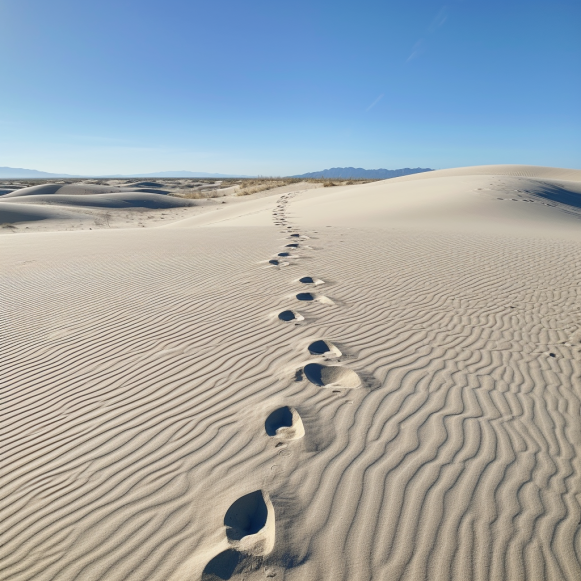Bay Area study helps confirm age of ghostly human footprints

Skeptics contended that footprints could not be 23,000 years old. Scientists from the Bay Area proved their age.
Tree pollen discovered in ancient sand and analyzed by Bay Area scientists confirms that humans existed in North America as long as 23,000 years ago, much earlier than previously thought.
The pollen, discovered alongside ghostly human footprints in New Mexico’s White Sands National Park, adds to evidence that people arrived long before the glaciers melted during the Ice Age. They also behaved similarly to us, carrying children, slipping in mud, and hunting wild animals for food.
U.S. Geological Survey research geologists announced the proposed age of these remarkable footprints in 2021, but the discovery was so extraordinary that it required additional testing. Scholars questioned it, claiming that the research method was prone to producing unreliable results.
The claim was controversial because it contradicted the previously held belief that the tracks belonged to people who migrated from Asia across a land bridge into Alaska 14,000 years ago, after the melting of Ice Age glaciers opened up new corridors, resulting in the famed Clovis Culture.
According to the 2021 study, America’s first settlers arrived much earlier. They could have come from Alaska via the glacier-free coast. Perhaps they arrived before glaciers cut off routes. If they arrived in what is now New Mexico more than 20,000 years ago, they must have begun their journey much earlier.
Susan Zimmerman of Lawrence Livermore National Laboratory and UC Berkeley, as well as U.S. Geological Survey geographer David Wahl, studied pollen grains, one of nature’s most durable organic materials, to test the veracity of that contentious estimate.
Their findings, which were published in the journal Science recently, backed up the original finding. A second technique, known as optically stimulated luminescence, did the same.
“It’s exciting…”This is an example of the amazing science that the lab can do,” said Zimmerman, a geochronologist at LLNL’s Center for Accelerator Mass Spectrometry who studies the historical patterns and mechanisms of the Earth’s changing climate.
“As scientists, we really want to understand what happened,” she added.
Nobody knows who these early humans were or whether they were related to the region’s modern Native groups.
White Sands National Monument is now a desert with no native trees and only shrubs. Summer temperatures can reach 110°F, and miles of bright white sand ripples. White Sands Missile Range, the US Army’s largest land-based open-air testing site, is nearby.
However, it was once home to the 1,600-square-mile Lake Otero. Small seasonal ponds and flat muddy basins formed as the lake slowly evaporated over time.
The area was densely forested with fir, spruce, and pine trees, as well as people.
The Park has the largest collection of fossilized footprints in the world. Those footprints were discovered in 2009 and are believed to be no more than 13,000 years old. They are joined by mammoth, sloth, bison, camel, dire wolves, saber-toothed cats, and other extinct species’ footprints, which number in the hundreds of thousands. Sediments filled in the prints over time, but erosion recently revealed them.
The prints enable scientists to identify a wide range of familiar behaviors.
One set of tracks appears to be the property of a young person, possibly carrying a toddler. Stride lengths indicate that they were moving quickly through the slick mud, at a rate of about 5.5 feet per second. The prints of the person deepen and rotate, indicating that they shifted the child from hip to hip. In one case, they’re joined by tiny footprints, indicating that the rambunctious child was put down.
Other tracks may be evidence of hunting. Human footprints can be found directly inside the tracks of a giant ground sloth. A second set of footprints on tiptoe can be found on the side, indicating that someone else attempted to sneak up on the prey.
Other tracks show evidence of horseplay, such as jumping, slipping, and skipping in the mud.
“The footprints are simply stunning,” Zimmerman exclaimed. “The detail of the behaviors seen in humans and animals — it’s a very unusual archive of information.” Archaeologists typically discover stone tools or buried bones.”
“The very important question was: When were these people and animals walking around together?” she went on to say.
Radiocarbon dating was used by USGS researchers and an international team of scientists to date seeds in the sand. This method can determine when a plant died because living materials contain radioactive carbon that decays at a known rate after death.
Archeologists, however, disputed the claim that the footprints were much older than previously thought. The main source of contention was that the seeds used in the study came from an aquatic plant called spiral ditchgrass. Because the plants are submerged, they absorb carbon from water rather than from the atmosphere. This can lead to unreliable dating because water may contain dissolved carbon from ancient rocks, making the seeds appear older than they are.
Instead, the researchers focused on tree pollen in the new follow-up study. UCB’s Wahl collected the samples found in the footprints from the same locations as the original seeds.
The 75,000 pollen grains were painstakingly separated from the sand by the team. The cells were then purified cell by cell at Indiana University’s Flow Cytometry Core Facility.
Each sample’s carbon isotope composition was then determined using mass spectrometry at LLNL’s Center for Mass Spectrometry.
The pollen age was statistically identical to the seed age in each case.
In addition, a USGS team based in Denver used a different method called optically stimulated luminescence to determine when the footprint-bearing quartz soil was last exposed to sunlight. It, too, came to the conclusion that the steps were at least 21,500 years old.
“Our targeted methodology in this current research really paid off,” said Jeff Pigati, co-lead author of the new study and a USGS research geologist.
There is now solid evidence that humans roamed North America thousands of years earlier than previously thought, based on three separate lines of evidence.If the studies had disagreed, Zimmerman said, there would be more work to be done.
“But the answers made the story clearer, rather than more complicated,” she went on to say. “And that’s pretty cool.”






